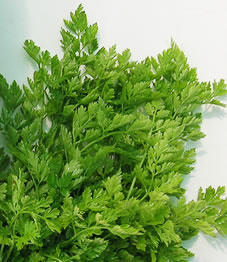Chervil
Dill
Absinthe
Basil
Borage
Calamint
Capers
Chervil
Coriander
Tarragon
Chives
Wild fennel
Lavender
Lovage
Lippia Citriodora
Marjoram
Lemon balm
Mint
Myrtle
Oregano
Chilli pepper
Salad burnet
Parsley
Rosemary
Garden rocket
Rue
Sage
Celery
Thyme
Valerian
HISTORICAL HINTS:
Chervil is originally from the Eastern Mediterranean area and was imported to Italy by Romans.
THE PLANT -
Chervil (Anthriscus cerefolium) is an annual herbaceous plant of the Apiaceous family. It has an average height of 40-70 cm and its leaves are quite small and light green. Chervil flowers are white, oval and 1 cm long on average. Chervil leaves are used to aromatize different dishes.
PRODUCTION –
Chervil can be cultivated both in pot and in soil but, in Europe, it is not unusual to find it wild. To obtain a stronger aroma, leaves can be harvested before flowering, so in springtime.
PRESERVATION –
Chervil aroma is very delicate but it desappears both with drying and with freezing.
PROPERTIES –
Chervil is rich in vitamin C, carotene and magnesium; it helps liver in digesting and it is beneficial to blood circulation, in fact, it is used to cure chilblains, bruises, insect bites, inflamed eyes, and skin rush. Thanks to its emollient properties, chervil compress make skin more tonic, less greasy and it is useful to prevent skin aging and wrinkles. Dried chervil is difficult to preserve because aromatic qualities of the fresh herb are lost. Chervil decoction was used in past times to clean skin rushes in newborns. Infusion treats empathic colic, rheumatisms, gout and menstrual pains. It is considered to be a blood purifier.
Chervil roots infusion can help treating depression. Putting chervil branches in store cupboards keeps ants away from food. Farmers plant chervil bushes to attract snails so that they do not damage the remaining cultivation.
CULINARY USE –
Chervil use in cooking is very similar to parsley use, in fact, they belong to the same family. It is rather hard to find fresh chervil in Italy, where the dried herb – with a more intense flavour - is more common. Chervil can be added to soups, white meats (chicken, rabbit) and eggs. It fits well also with legumes as beans, broad beans and peas. In France, where there is a great consumption, chervil is also used with omelettes and salads. It is better to add chervil at the end of cooking so to maintain its properties and its pleasant taste.























